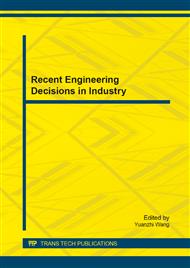[1]
G.W. Housner: First World Conference on Earthquake Engineering (Berkeley, California 1956).
Google Scholar
[2]
A. Arias: Seismic Design for Nuclear Power Plants, edited by R.J. Hansen, MIT Press, Cambridge, MA, (1970).
Google Scholar
[3]
J.L. Von-Thun, L.H. Rochin, G.A. Scott and J.A. Wilson: Earthquake Engineering and Soil Dynamics II – Recent Advance in Ground-Motion Evaluation, ASCE, New York (1988).
Google Scholar
[4]
E. Cosenza and G. Manfredi: 11th European Conference on Earthquake Engineering, Paris, France (1998).
Google Scholar
[5]
P.P. Cordova, G. G Dierlein, S.S.F. Mehanny and C.A. Cornell: The second U.S. -Japan Workshop on Performance-Based Earthquake Engineering Methodology for Reinforce Concrete Building Structures, Sapporo, Hokkaido (2001).
Google Scholar
[6]
J.W. Baker and C.A. Cornell: Earthquake Engineering and Structural Dynamics Vol. 36 (2007).
Google Scholar
[7]
P. Tothong and N. Luco: Earthquake Engineering and Structural Dynamics Vol. 34 (2005).
Google Scholar
[8]
S.S.F. Mehanny: Engineering Structures Vol. 31 (2009).
Google Scholar
[9]
E. Bojórquez and I. Iervolino: Soil Dynamics and Earthquake Engineering Vol. 37(7) (2011).
Google Scholar
[10]
N. Buratti: The 15th World Conference on Earthquake Engineering, Lisboa, Portugal (2012).
Google Scholar
[11]
A. Modica and P.J. Stafford: Bulletin of Earthquake Engineering (2014), in press.
Google Scholar
[12]
E. Bojórquez, A. Reyes-Salazar, S.E. Ruiz and J. Bojórquez: Mathematical Problems in Engineering Vol. (2013).
Google Scholar
[13]
A. Terán-Gilmore: Revista de ingeniería Sísmica Vol. 65 (2001).
Google Scholar
[14]
E. Bojórquez and S.E. Ruiz: 13th World Conference on Earthquake Engineering Vancouver, Canada (2004).
Google Scholar
[15]
D. Arroyo and M. Ordaz: Journal of Earthquake Engineering Vol. 11 (2007).
Google Scholar
[16]
A. Terán-Gilmore and J.O. Jirsa: Earthquake Engineering and Structural Dynamics Vol. 36 (2007).
Google Scholar
[17]
E. Bojórquez, S.E. Ruiz and A. Terán-Gilmore: Engineering Structures Vol. 30(6) (2008).
Google Scholar
[18]
A. Terán-Gilmore, A. Sánchez-Badillo and M.A. Espinosa-Johnson: Earthquakes and Structures Vol. 1(1) (2010).
Google Scholar
[19]
E. Bojórquez, A. Reyes-Salazar, A. Terán-Gilmore and S.E. Ruiz: Steel and Composite Structures Vol. 10(4) (2010).
Google Scholar
[20]
E. Bojórquez, A. Terán-Gilmore, S.E. Ruiz and A. Reyes-Salazar: Earthquake Spectra Vol. 27(3) (2011).
Google Scholar
[21]
M.D. Trifunac and A.G. Brady: Bulletin of the Seismological Society of America Vol. 65(3) (1975).
Google Scholar
[22]
E. Bojórquez, I. Iervolino and G. Manfredi: Seismic Engineering International Conference commemorating the 1908 Messina and Reggio Calabria Earthquake MERCEA'08.
Google Scholar


